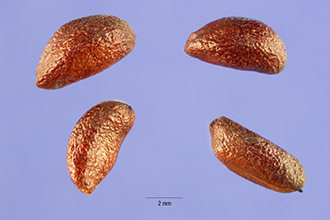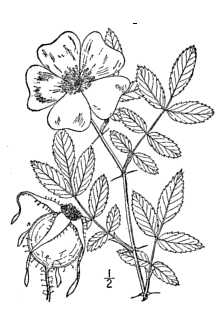Virginia Rose
Scientific Name: Rosa virginiana Mill.

| General Information | |
|---|---|
| Usda Symbol | ROVI2 |
| Group | Dicot |
| Life Cycle | Perennial |
| Growth Habits | Subshrub |
| Native Locations | ROVI2 |
Plant Guide
Alternate Names
pasture rose, wild rose, common wild rose , Use soil moisture sensors to measure the soil moisture of Virginia Rose.
Uses
Ethnobotanic: The seed was a good source of vitamin E, it was grounded into a powder and mixed with flour or added to other foods as a supplement (Facciola 1990). A decoction of the roots was used as a bath and to treat worms in children (Moerman 1998). An infusion of the roots was used to treat bleeding cuts on the feet and as a wash to treat sore eyes (Ibid.). The fruit served as a good source of essential fatty acids, which is fairly rare for a fruit. Medical: It is being investigated as a food that is capable of reducing the incidence of cancer and also as a means of halting or reverting the growth of cancer (Matthews 1994). The fruits are high in vitamin C and may be eaten out of hand or used to make preserves. Britton, N.L., and A. Brown. 1913 Illustrated flora of the northern states and Canada. Vol. 2: 285. Courtesy of Kentucky Native Plant Society.
Status
Please consult the Plants Web site and your State Department of Natural Resources for this plant’s current status, such as, state noxious status, and wetland indicator values.
Description
General: Rose family (Roseaceae). Virginia rose (Rosa virginiana) is an upright shrub growing between four to six feet tall. The glossy dark green foliage develops excellent yellow to red fall color (Dirr 1997). This species bears fragrant pink flowers that are two to three-inches in diameter and occur in clusters of five to eight. Distribution: Rosa virginiana ranges from Arkansas, east to Alabama, north to Newfoundland and west to Ontario (Vines 1960). For current distribution, please consult the Plant profile page for this species on the PLANTS Web site.
Adaptation
Virginia rose grows along the edges of salt marshes, roadsides and in pastures. This species succeeds in moist soils, growing well in heavy clayey soils. It prefers a sunny position and does well under winter conditions. This is an outstanding ornamental shrub that is easy to grow.
Establishment
Propagation by Seed: Most rose seeds often take one to two years to germinate because of an immature embryo and a hardened seed coat. To reduce the waiting period, scarify the seed and place in damp peat at a temperature of 27 to 32ºC for four to five months by which the seed should began to germinate. Place the seedlings into individual pots when they are large enough to handle. Out plant seedling in the summer if the plants are more than twenty-five centimeters tall, otherwise grow in a cold frame for the winter and out plant in late spring.
Management
Pruning should be done to remove spent blooms and diseased areas after winter for winter injury, and to shape a plant. Roses are one of the most susceptible ornamentals to most pests and require control from intensive IPM control programs. Beneath the flesh of the fruit, there is a layer of hairs around the seeds that can cause irritation to the mouth and digestive tract if ingested. Cultivars, Improved and Selected Materials (and area of origin) Materials are somewhat available through native plant nurseries. Contact your local Natural Resources Conservation Service (formerly Soil Conservation Service) office for more information. Look in the phone book under ”United States Government.” The Natural Resources
Conservation
Service will be listed under the subheading “Department of Agriculture.”
References
Dirr, M. A. & C. W. Heuser, Jr. 1987. The reference manual of woody plant propagation: from seed to tissue culture. Varsity Press, Athens, Georgia. Dirr, M.A. 1997. Dirr’s hardy trees and shrubs: an illustrated encyclopedia. Timber Press, Portland, Oregon. Facciola, S. 1990. Cornucopia - a source book of edible plants. Kampong Publications. Genders, R. 1994. Scented flora of world. Robert Hall, London. Grimm, W.C. 1970. Home guide to trees, shrubs, and wildflowers. Stackpole Books, Harrisburg, Pennsylvania. Heuser, C. W. 1997. The complete book of plant propagation. The Taunton Press, Newtown, Connecticut. Matthews, V. 1994. The new plantsman. Vol. 1. Royal Horticultural Society. Moerman, D. 1998. Native American ethnobotany. Timber Press, Portland, Oregon. Rehder, A. 1940. Manual of cultivated trees and shrubs: hardy in North America. The MacMillan Company, New York, New York. Riotte, L. 1978. Companion planting for successful gardening. Garden Way, Vermont.
Plant Traits
Growth Requirements
| Temperature, Minimum (°F) | -18 |
|---|---|
| Adapted to Coarse Textured Soils | Yes |
| Adapted to Fine Textured Soils | No |
| Adapted to Medium Textured Soils | Yes |
| Anaerobic Tolerance | Low |
| CaCO3 Tolerance | Low |
| Cold Stratification Required | Yes |
| Drought Tolerance | Low |
| Fertility Requirement | Medium |
| Fire Tolerance | High |
| Frost Free Days, Minimum | 130 |
| Hedge Tolerance | None |
| Moisture Use | Medium |
| pH, Maximum | 7.0 |
| pH, Minimum | 5.0 |
| Planting Density per Acre, Maxim | 4800 |
| Planting Density per Acre, Minim | 700 |
| Precipitation, Maximum | 55 |
| Precipitation, Minimum | 35 |
| Root Depth, Minimum (inches) | 16 |
| Salinity Tolerance | None |
| Shade Tolerance | Intermediate |
Morphology/Physiology
| Bloat | None |
|---|---|
| Toxicity | None |
| Resprout Ability | Yes |
| Shape and Orientation | Semi-Erect |
| Active Growth Period | Spring and Summer |
| C:N Ratio | Medium |
| Coppice Potential | No |
| Fall Conspicuous | Yes |
| Fire Resistant | No |
| Flower Color | Purple |
| Flower Conspicuous | Yes |
| Foliage Color | Green |
| Foliage Porosity Summer | Dense |
| Foliage Porosity Winter | Moderate |
| Foliage Texture | Medium |
| Fruit/Seed Conspicuous | Yes |
| Nitrogen Fixation | None |
| Low Growing Grass | No |
| Lifespan | Moderate |
| Leaf Retention | No |
| Known Allelopath | No |
| Height, Mature (feet) | 6.0 |
| Height at 20 Years, Maximum (fee | 6 |
| Growth Rate | Moderate |
| Growth Form | Rhizomatous |
| Fruit/Seed Color | Red |
Reproduction
| Vegetative Spread Rate | Slow |
|---|---|
| Small Grain | No |
| Seedling Vigor | Medium |
| Seed Spread Rate | Slow |
| Fruit/Seed Period End | Summer |
| Propagated by Tubers | No |
| Propagated by Sprigs | No |
| Propagated by Sod | No |
| Propagated by Seed | Yes |
| Propagated by Cuttings | No |
| Propagated by Container | Yes |
| Propagated by Bulb | No |
| Propagated by Bare Root | Yes |
| Fruit/Seed Persistence | Yes |
| Fruit/Seed Period Begin | Summer |
| Fruit/Seed Abundance | High |
| Commercial Availability | No Known Source |
| Bloom Period | Late Spring |
| Propagated by Corm | No |
Suitability/Use
| Veneer Product | No |
|---|---|
| Pulpwood Product | No |
| Protein Potential | Low |
| Post Product | No |
| Palatable Human | No |
| Palatable Graze Animal | Low |
| Palatable Browse Animal | Low |
| Nursery Stock Product | No |
| Naval Store Product | No |
| Lumber Product | No |
| Fodder Product | No |
| Christmas Tree Product | No |
| Berry/Nut/Seed Product | No |

